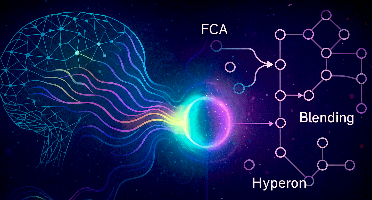
SophiaBot
Project OwnerLead architect & researcher. Designs framework, codes core logic in MeTTa, manages expert team, LLM evals, benchmarks, & delivers final Hyperon-integrated AGI demo.
DEEP Connects Bold Ideas to Real World Change and build a better future together.
Coming Soon
Harmonic Concept Synthesis for MeTTa Proposing a hybrid method to advance AGI: merging fuzzy/paraconsistent FCA with concept blending inside MeTTa for Hyperon. I bring 20+ years across AI, TRIZ (NASA-trained), marketing, & music theory, blending logic & creativity like a composer. Backed by real-world experts (NASA, Marines, UT Acoustician), I’ll code, test, & validate novel concepts scored by LLMs (Claude 4.0, ASI). Includes audio-based concept analysis & modular design for integration. Budget: $50K, milestones mapped, and fallback plans in place.
This RFP seeks proposals that experiment with concept blending techniques and formal concept analysis (including fuzzy and paraconsistent variations) using the MeTTa programming language within OpenCog Hyperon. The goal is to explore methods for generating new concepts from existing data and concepts, and evaluating these processes for creativity and efficiency. Bids are expected to range from $30,000 - $60,000.
Initiate deep research into merging fuzzy/paraconsistent Formal Concept Analysis (FCA) with concept blending models in MeTTa. Analyze strengths limitations & compatibility with Hyperon's symbolic architecture. Design a modular framework that supports both structured and probabilistic reasoning. Consultation with TRIZ/physics expert Mark Fox will guide logic system modeling and systemic integration. Agile 4-week sprints will be planned for subsequent milestones.
- Comparative analysis of FCA vs. concept blending in MeTTa - Modular system design diagram for Hyperon integration - TRIZ-informed logic flow documentation - Sprint plan and milestone roadmap - Versioned documentation repository (GitHub Notion etc.)
$10,000 USD
- Completion of FCA vs. blending analysis with clear pros/cons - Modular design validated by expert review (TRIZ/Mark Fox) - Draft architecture aligns with Hyperon integration goals - Agile sprint breakdown delivered for next phases - All research artifacts stored in a version-controlled repo and team-shared
Implement fuzzy/paraconsistent FCA & information-theoretic concept blending modules in MeTTa. Develop code to integrate these systems into Hyperon-compatible structures via DAS. Evaluate outputs using Claude 4.0 ASI & LLaMA3 for novelty coherence & memory retention. Begin testing audio-mapped representations of abstract traits. Utilize local LLM agents to enhance reasoning persistence & mitigate external API limitations.
- Functional MeTTa modules for fuzzy FCA and concept blending - DAS integration code & logic mapping - Logs and evaluation reports from LLMs (Claude ASI LLaMA3) - Jupyter or CLI-based prototype demonstrating core functionality - Initial concept-to-audio modeling samples (where applicable)
$20,000 USD
- Stable execution of both FCA & blending modules within MeTTa - Working DAS pipeline that integrates synthesized concepts into Hyperon - Concepts meet thresholds: novelty >8/10, coherence >70% - Evaluation results confirmed across multiple LLMs - Prototype successfully demonstrates symbolic + blended logic interplay - Audio model demonstrates perceivable correlation with cognitive metrics
Finalize all systems benchmark performance & document the entire architecture. If MeTTa's limitations block paraconsistent or fuzzy logic pivot to embedding logic in LISP or Prolog with wrappers for Hyperon compatibility. Validate all outputs using LLMs & ensure long-term memory retention in Hyperon. Create a full demo showcasing concept synthesis blending & symbolic persistence through Hyperon’s memory pipeline.
- Complete documentation (APIs logic modules fallback engines) - Benchmark report showing novelty >8/10 coherence >70% & 24+ hr memory retention - Recorded demo of concepts entering & persisting in Hyperon - Reusable codebase with clean modular structure - Optional LISP/Prolog logic layer with symbolic compatibility
$20,000 USD
- Concepts persist in Hyperon memory >24 hours with no degradation - All benchmarks hit or exceeded (novelty, coherence, retention) - Final codebase is reusable, well-documented, & compatible with Hyperon - Demo illustrates full pipeline: input → synthesis → retention - Fallback logic system tested if MeTTa tools fall short - All deliverables are published in versioned repo & ready for team or community reuse
Reviews & Ratings
Please create account or login to write a review and rate.
Check back later by refreshing the page.
© 2025 Deep Funding
Join the Discussion (0)
Please create account or login to post comments.